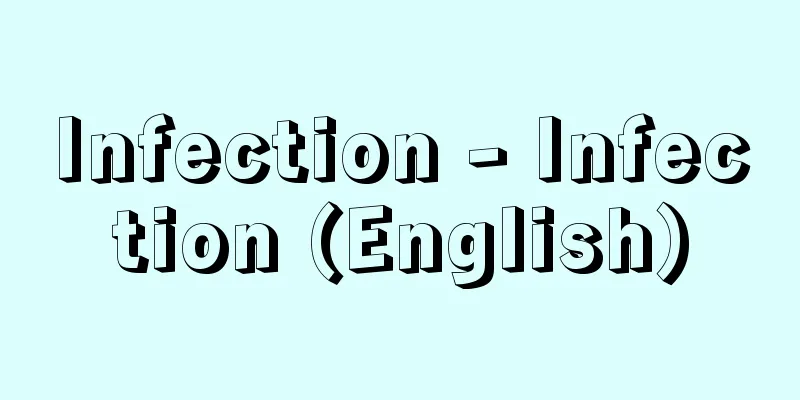Infection - Infection (English)

|
It refers to when pathogenic microorganisms or small animals invade the human or animal body and grow in organs or tissues. Diseases caused by infection are called infectious diseases, and pathogenic microorganisms or small animals that cause infectious diseases are called pathogens. Pathogens include viruses, chlamydia, rickettsia, bacteria, fungi (molds), spirochetes, protozoa, and parasites, and the pathology of an infectious disease varies depending on the type of pathogen. This is due to the pathogen itself or toxins released by the pathogen. Infection does not necessarily lead to disease. For example, some people who are infected with the Japanese encephalitis virus may develop symptoms such as high fever, headache, impaired consciousness, and convulsions, but the majority of people do not develop symptoms such as fever even if the virus multiplies in their body, and do not develop the disease. In this way, infection that leads to disease is called overt infection, and infection that does not lead to disease is called asymptomatic infection or latent infection. The difference between these two is whether symptoms are noticeable or not, not an absolute difference in whether there are pathological changes or not. In other words, the difference between the two is the quantitative difference in the lesions. The percentage of people who develop the disease among those infected is called the infection onset index or susceptibility index, and is almost constant for infectious diseases, especially respiratory infections. According to this, the majority of people develop the disease from measles (95%) and whooping cough (60-80%), while the majority of people do not develop the disease from diphtheria (10%) or Japanese encephalitis (less than 0.2%). Also, if an individual becomes infected and develops a disease, the individual is said to be susceptible to the pathogen, and if the individual does not develop a disease, the individual is said to be non-susceptible. In other words, susceptibility means an individual's resistance to a pathogen. When an organism is not susceptible to a pathogen, or when susceptibility is weakened, this is called immunity. Sources of infection include patients, carriers, other infected animals, vector animals, excreta containing pathogens, or objects contaminated by them, and routes of infection are the ways in which pathogens enter the body directly or indirectly from these sources. There are three routes: excretion, transmission, and invasion. Pathogens are excreted from the respiratory tract (cough, phlegm, nasal discharge), digestive tract (saliva, feces, vomit), urinary tract (urine), reproductive tract (secretion fluid, placenta), eyes (secretion fluid), and skin (pus, scabs), but pathogens present in blood and lymph are expelled from the body by vector arthropods (mosquitoes, lice, fleas, ticks, stable flies, etc.). The routes of transmission by which excreted pathogens or pathogens multiplying in food or soil reach new susceptible organisms include airborne, contact, waterborne, and through the bite of arthropod vectors. They can also be carried by flies, cockroaches, and rats. Routes of entry include respiratory, oral, percutaneous, and transplacental. Respiratory infection is airborne, while oral infection is generally caused by pathogens excreted from the digestive tract being ingested mixed with food and drink and entering the body through the digestive tract. Percutaneous infection can occur through arthropod bites or contaminated needles, but contact infection occurs when pathogens enter the body through wounds in the skin or mucous membranes that are not visible to the naked eye. Transplacental infection occurs when a pregnant woman is infected and the pathogen passes through the placenta to invade the fetus, and is also called vertical infection. Other terms that refer to modes and routes of infection include "mixed infection," "bloodborne infection," "autoinfection," "horizontal infection," "group infection," "nosocomial infection," and "opportunistic infection," for which please refer to the respective entries. [Noriaki Yanagishita] Nakahara Hideomi and Sagawa Takashi, What does it mean to be infected? - What happens between infection and onset of illness (1995, Kodansha) ▽ Shimizu Kihachiro (ed.), Yamaguchi Keizo and Iwamoto Aikichi, Infectious diseases that anyone can understand (1999, Health Publishing) ▽ Infectious disease files - Pathogens creeping up on us (2000, Takeuchi Shoten Shinsha) ▽ Honda Takeshi and Iijima Yoshio, Infectious diseases that are targeting you (2000, Shogakukan) ▽ Aikawa Masamichi and Nagakura Mitsukazu, Modern infectious diseases (Iwanami Shinsho) ▽ Inoue Sakae, The age of infectious diseases (Kodansha Gendai Shinsho) [Reference items] | | | | | | | | | | | | | | |Source: Shogakukan Encyclopedia Nipponica About Encyclopedia Nipponica Information | Legend |
|
病原微生物や小動物が人体または動物体に侵入し、臓器や組織中で増殖することをいう。感染によっておこる疾患を感染症といい、感染症をおこす病原微生物や小動物を病原体という。病原体にはウイルス、クラミジア、リケッチア、細菌、真菌(カビ)、スピロヘータ、原虫、寄生虫などが含まれ、病原体の種類によって、その感染症の病態がそれぞれ異なる。これは、病原体そのもの、あるいは病原体から出る体外毒素による。 感染すればかならず発病するとは限らない。たとえば日本脳炎ウイルスが感染すると、高熱、頭痛、意識障害、けいれんなどの症状を呈する人もあるが、大多数の人は体内でウイルスが増殖してもその程度が少なく、発熱などの症状もなく発病しない。このように、感染を受けて発病する場合を顕性感染、発病しない場合を不顕性感染または潜伏感染という。この両者の差は自覚的に症状が現れるか否かであり、病的変化があるか否かの絶対的差異ではない。つまり両者の差は病変の量的差異といえる。なお、感染を受けた者のうち、発病する者の割合を感染発症指数または感受性指数といい、感染症とくに呼吸器感染症ではほぼ一定している。これによると、麻疹(ましん)(95%)や百日咳(ぜき)(60~80%)などでは大多数の人が発病するし、逆にジフテリア(10%)や日本脳炎(0.2%以下)などでは大多数の人は発病しない。 また、感染を受けて発病する場合、その個体はその病原体に対して感受性があるといい、発病しない場合には感受性がないという。感受性は逆の立場からいえば個体の病原体に対する抵抗性を意味する。生体が病原体に対して感受性をもたないか、あるいは感受性が減弱された状態にあることを免疫という。 感染の源となるもの、すなわち患者や保菌者、そのほか感染動物や媒介する動物、あるいは病原体を含んだ排出物やそれらによって汚染されたものなどを感染源といい、これらの感染源から直接または間接に生体内へ病原体が侵入する道筋を感染経路という。これには排出、伝播(でんぱ)、侵入の3経路がある。病原体の排出は、呼吸器(咳、痰(たん)、鼻汁)、消化器(唾液(だえき)、糞便(ふんべん)、吐物)、泌尿器(尿)、生殖器(分泌液、胎盤)、眼(分泌液)、皮膚(膿(のう)、痂皮(かひ))から行われるが、血液やリンパ液中に存在する病原体は、媒介する節足動物(カ、シラミ、ノミ、ダニ、サシバエなど)が体外に出す役割を果たす。排出された病原体、あるいは食品や土の中で増殖していた病原体が新しい感受性のある生体に到達する伝播経路としては、空気感染、接触感染、水系感染のほか、媒介者である節足動物に刺されることによるものがある。またハエやゴキブリ、ネズミなどによる運搬もある。侵入経路としては、経気道、経口、経皮および経胎盤がある。経気道感染は空気感染によるものであり、経口感染は、一般に消化器から排出された病原体が飲食物に混じって摂取され消化器から侵入することによる。経皮感染は、節足動物の刺咬(しこう)、あるいは汚染された注射針によることもあるが、肉眼では見えないような皮膚や粘膜の創傷(そうしょう)から侵入する場合は、接触感染のときにみられる。経胎盤感染は、妊婦が感染したとき、病原体が胎盤を通過して胎児に侵入し、感染するもので、垂直感染ともいう。 このほか感染の様式や経路として、「混合感染」「血行感染」「自己感染」「水平感染」「集団感染」「院内感染」「日和見(ひよりみ)感染」などの用語があるが、これらはそれぞれの項目を参照されたい。 [柳下徳雄] 『中原英臣・佐川峻著『感染するとはどういうことか――「感染」と「発病」の間に起きていること』(1995・講談社)』▽『清水喜八郎監著、山口恵三・岩本愛吉著『だれでもわかる感染症』(1999・へるす出版)』▽『『感染症ファイル――しのびよる病原体』(2000・竹内書店新社)』▽『本田武司・飯島義雄著『あなたを狙う感染症』(2000・小学館)』▽『相川正道・永倉貢一著『現代の感染症』(岩波新書)』▽『井上栄著『感染症の時代』(講談社現代新書)』 [参照項目] | | | | | | | | | | | | | | |出典 小学館 日本大百科全書(ニッポニカ)日本大百科全書(ニッポニカ)について 情報 | 凡例 |
Recommend
Ode to a Greek Vase
…Hölderlin's collection of poems, deeply insp...
Pinakotheke (English spelling)
…An ancient Greek school, so to speak, especially...
rock
A popular music genre that was born in the United ...
harpsichord
A plucked string instrument with a keyboard (see s...
Beating
A type of cooking method in Japanese cuisine, and ...
Hasan al-Banna (English spelling)
1906‐49 Murshid was the first leader of the Muslim...
Acceptance - Joji
〘Noun〙 (Also "Shoji". "Jo" is ...
Aloe ferox - Aloe ferox
…All the leaves are fleshy and usually grow in a ...
Hemu (English spelling)
...Humayun died soon after returning to the thron...
Ooamana - Ooamana
...The flowers are mostly white, with thick petal...
Nikko Incident
A conflict that occurred during the Siberian Expe...
Araumi Shoji - Araumi Shoji
This shoji screen stands in front of the Hagi door...
Direct cost, indirect cost
Cost elements that can be directly recognized as h...
Fujiokaya Diary - Fujiokaya Diary
This is a collection of records centered on Edo fr...
Cicadetta yezoensis (English spelling)
…Cicada [Masami Hayashi]. . … *Some of the termin...









